This post is an important beginning for your health. While I realize that there are some people who genuinely need to avoid gluten completely (celiacs, mainly), for the rest of us it makes sense to ferment the wheat (or other grains) before eating. It’s true that grain in its natural form really isn’t great food for humans. It’s coated with phytic acid and many other anti-nutrients. But, with the brains that we have, humans have learned over the millennia how to make that grain more digestible by fermentation. Fermentation is almost like a second stomach for us, predigesting and adding all kinds of beneficial bacteria for us before we even put it in our mouths! Amazing!!!
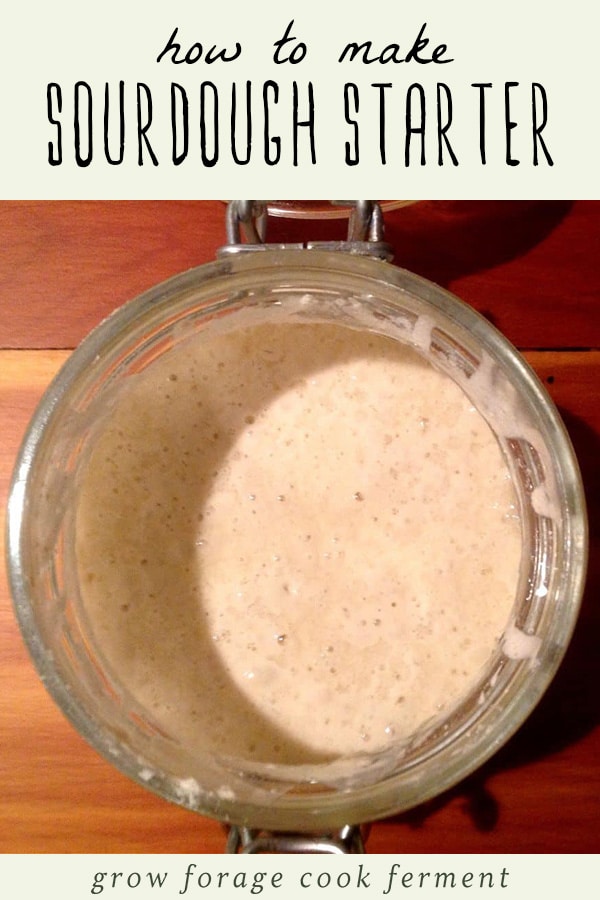
I’m not going to lie, the absolute best way to get a sourdough starter going is by getting a spoonful of starter from a friend. Then all you have to do is add a little flour and water to it and it will continue to be awesome. A little bird gave me some sourdough starter from the Ahwahnee Hotel in Yosemite (I have some inside connections :), which is older than than the hills. It smells and looks amazing, like a loaf of fresh baked sourdough.
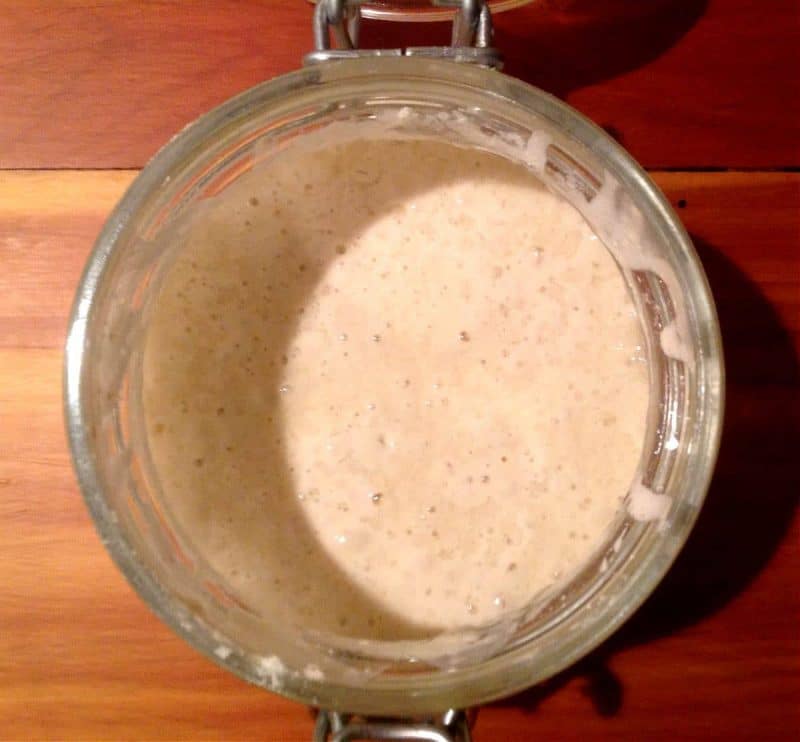
How to Make Sourdough Starter
All you really need is flour and water and time. A warm room helps, and so does adding a few organic grapes as the bloom on their skins adds some of the beneficial bacteria that is wanted.
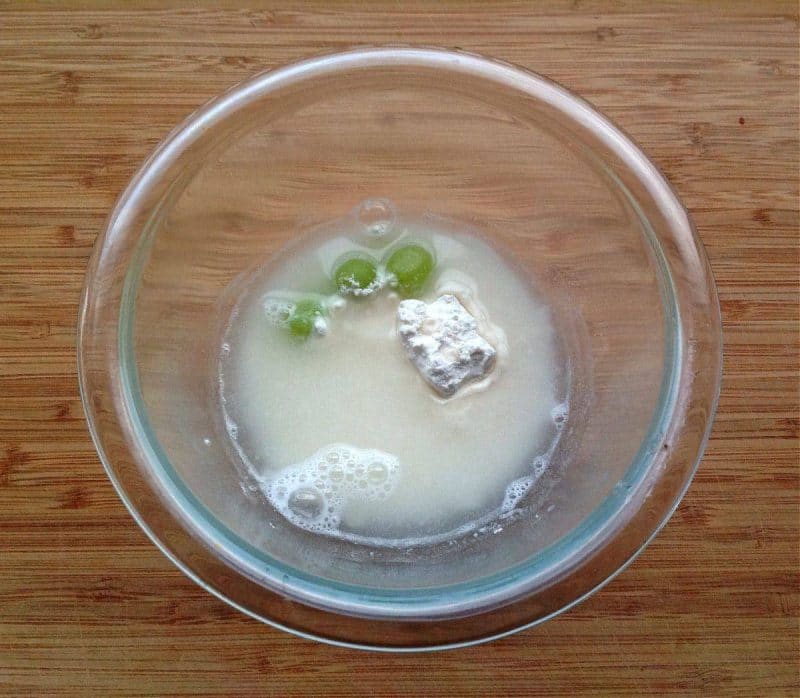
Cover the starter loosely with a towel and leave it in a warm place, like the top of your fridge. Feed it a spoonful of flour and a little warm water every morning and night. Stir it up vigorously, a whisk works well, to distribute all of the wild yeast that is forming.
My starter was bubbling a little after a day or so, but I read that smashing the grapes helps even more by giving the yeast a little sugar to eat. Here is what it looked like after I did that.
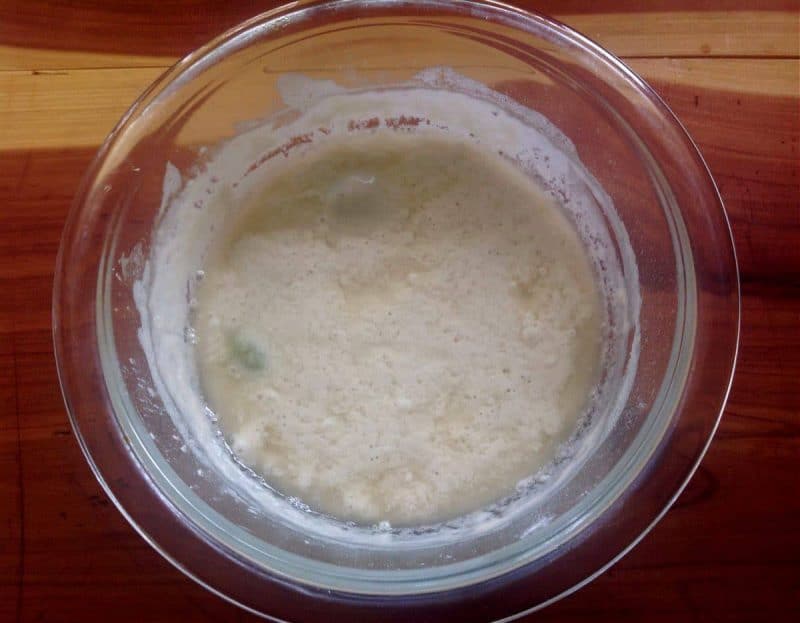
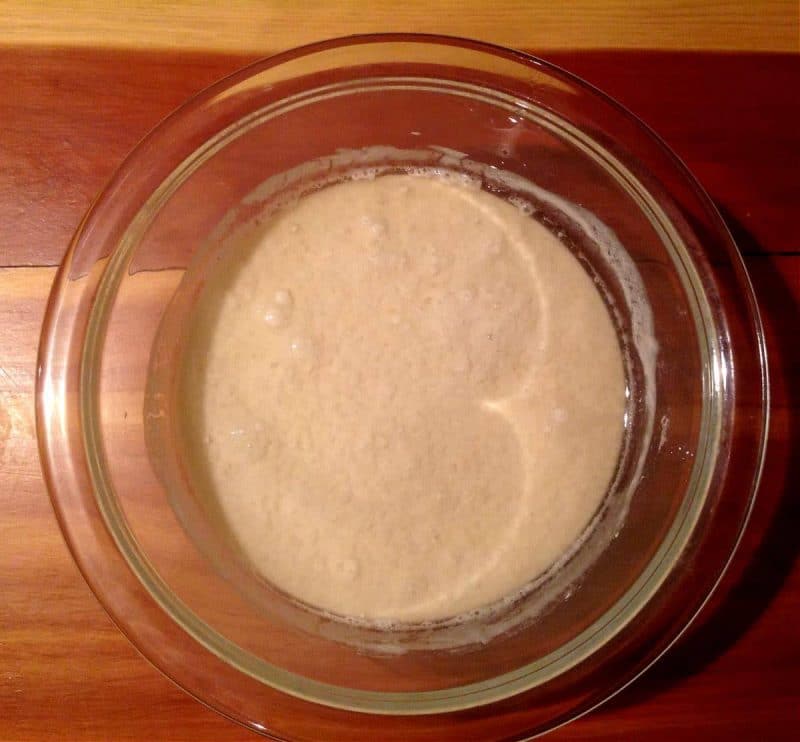
Sourdough Starter Troubleshooting
If you’re having trouble getting your starter to bubble, there is a trick, although I like to leave this as a last resort. You can add a teensy, tiny pinch of regular bread yeast. As long as you let it sit out on your counter and continue to feed it with flour and water it will still be sourdough. Don’t feel bad if you have to do it, I’ve done it on numerous occasions, but I always like to try to get it started with wild yeast first.
Once you start using your sourdough starter regularly you might find that you need to keep it out and continue to feed it so that you have more! As long as you have a little bit left in the jar you can always add more flour and water and it will sour right up. So easy and so healthy!
Now you probably know what’s coming next… Amazing sourdough bread!!! Here are a few of my favorite, delicious sourdough recipes:
- No-Knead Sourdough Bread
- Sourdough Rye Bread
- Sourdough Pizza
- Sourdough Blueberry Pancakes
- Sourdough Tortillas
How to Make Sourdough Starter
Ingredients
- 1/4 cup all purpose flour
- 1/4 cup tepid water
- 3 organic grapes optional
Instructions
- Stir together the flour and water until they are fully incorporated.
- Smash the grapes, if using, and mix them in.
- Cover the starter loosely with a towel and leave it in a warm place, like the top of your fridge.
- Feed it a spoonful of flour and a little warm water every morning and night. Stir it up vigorously, a whisk works well, to distribute all of the wild yeast that is forming.
- Continue to feed your starter every morning and night. (Don’t worry about how it smells.)
- After a couple days, fish out the grapes.
- Continue feeding the starter until it begins to smell sour. (Discard any excess starter.)
- Once it’s ready you can keep it in the fridge, but remember to pull it out and feed it at least once a week.
Notes
- If you’re having trouble getting your starter to bubble, there is a trick, although I like to leave this as a last resort. You can add a teensy, tiny pinch of regular bread yeast. As long as you let it sit out on your counter and continue to feed it with flour and water it will still be sourdough.

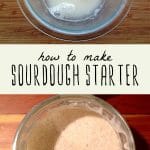


Saw on your juniper wild yeast starter that you can use it to help start your sourdough starter, which linked me to this article. I am not finding how to incorporate the wild yeast liquid into starting sourdough. Help please! I have a wild yeast juniper starter all ready to use! And I have a sourdough bread making class I am ‘attending’ next week. Here we go!
Hi Carla, I have heard about others that have had success with it, but I’ve never done it myself so I can’t really guide you on how to do it, sorry!
Trying sourdough starter, followed your recipe, but curious do I only lay a towel over top or can I shut the lid on the jar? Nowhere does anyone address this, but almost all jars I see recipe in have lids and they’re closed and latched. And how much flour and water daily; 1 tbsp and 1 tbsp?
I just place a towel over the top with a rubber band around the jar. It’s recommended to feed your sourdough starter daily with a ratio of 1:1 flour and water. You can use whatever amount you prefer.
I have a quick question – I have recently started my sourdough starter and things ARE bubbling! I read a trick which said you should throw a table spoon of apple cider or pineapple juice in at the very beginning to bring the PH down and help out the yeast so I did that and it’s already bubbling quite a bit after just 4 days of feeding. My question however is about the consistency of the starter. Mine is sorta doughy already – is it meant to be thick like a wet bread dough or thinner like a pancake mix kinda?
Need some advice – followed your recipe and have been feeding twice daily.
The starter smells sour but it is also separated with liquid floating out he top.
Is that ok?
Thank you!
Hi Colleen! When you are feeding it to get it started, you said feed it a spoonful of flour, I’m guessing a tablespoon? Also, how much water? Equal portions? Can’t wait to try this!
Thanks,
Pat
My Grandmothers recipe calls for potato water. Never heard of the grapes..going to try.
Can you tell me more about the process of “feeding” the starter? This is my first time with making my own. Do you just add flour and water? Does it have to sit at room temperature or do you just pull it out of the fridge and feed it and put it back? Any help would be appreciated! Thanks!
Got sourdough starter going. Been wanting to do this for years. Being retired I have spare time.
Remember reading about miner / prospectors in 1800’s. The kept their starter with them so it would not freeze,
Think it was Jack London books. Will have to look it up.
Really liking your sites.
Thanx
I can forage for some lovely juniper berries with white bloom on them. Grapes are an hour away. Is there any reason a tablespoon of them wouldn’t work also?
It would probably work, give it a try!
Diane,
Did the juniper berries work?
Hi, thanks for the good description! To maintain my starter (feeding it once a week), what is that water/flour ratio I need use? And I out it right back in the fridge after feeding? Or does it need to sit outside? Does the sourdough need to be taken out and come to room temperature before using it?
Sorry for all these questions, I’ve been baking according to Ken Forkish method and my bread turns out really well, but the timing for his breads is very different.
Thanks!
I can’t wait to try this, just have a question regarding the grapes. I have Concord grapes growing on my back fence but they won’t be really ripe until about October – do I have to wait until they are ripe for them to work in the starter?
As long as the grapes have some of that whitish bloom on them they should work whether they are completely ripe or not.
Great video! I was wondering about cabbage. I was reading an old 1800 cookbook and they were talking about getting yeast off of cabbage in the fall for baking. Did you ever do this and how do you do this. Thanks again; new subscriber; love your articles and how to videos. Bekki
I don’t have any grapes at home and want to start this. would a handful of organic raisins work to make the starter?
I’ve never tried it, but I’m thinking that it would probably work! Also, organic blueberries would work as well.
Hi Colleen how many days does this take please? I have Rice Flour, Buckwheat Flour, and All Purpose Flour but not bleached, I think I also have Coconut Flour? Would any of those work please? Thank you also for the recipes…
Everyone’s sourdough starter will take different amounts of time to make as there are several factors going on. I would say a week is a good guideline for it to get going, though. The only flour I would use for making the starter is regular all purpose (or rye if you have it), the gluten free flours won’t work as far as I know.
Where might we find an answer to the questions about amounts to add to feed starter and about the temperature?
….and I’m so in. You had me at “Ahwahnee”…I got to go on several trips to Yosemite and have eaten many times at the Ahwahnee Lodge, and everyone knows California has the best sourdough bread anywhere. (I grew up in the South Bay in Santa Clara Valley and am now all the way out on the east coast…and I miss authentic sourdough bred a LOT.)
I think you will enjoy having your own sourdough starter! When I smashed the grapes up a bit it seemed to really get it going good. Yosemite is awesome!
Great tutorial! It reminds me that I neeeeed to get a new sourdough starter going again :) Thanks for sharing at the Homestead Blog Hop!
The recipe I tried recommended rye flower and onion. It did bubble and smell of sourdough but the bread never really rose and was hard as a brick. I’ll try your’s as soon as I have my spring connected to the kitchen tap. Shouldn’t be long now…thanks for the passion and effort you put into these post.it benefits all of us.
Rye is difficult to work with because it has little gluten. So always do extra research when trying to work with rye. King Arthurs flour has many suggestions.
Thanks for these posts, I feel healthier just THINKING about miner’s lettuce and starting my own starter. I’ve convinced young James that sourdough bread is deeelish, so we should start making our own sourdough bread! I like how you write about these things–keep it up!
Thanks, glad you like it! I have a sourdough bread recipe in the works right now (just came out of the oven and smells amazing, actually) and will be on the blog next week!
Thank you so much for this! I thought it was going to be intimidating, but, just like all of your other posts, it seems manageable and fun. You have a wonderful blog!
Thank you! I really try hard to make these things accessible to everyone because they really are easy! I’m glad that you are liking it :)
I also shared this on Facebook. There are so many people who love to bake and brew and hope this helps them have great fun playing with this yeast recipe. Thanks again for all your hard work; greatly appreciated. Bekki.
This blog would make anybody want to have a sour dough starter in their kitchen!
amazing about the grapes…good job Colleen!